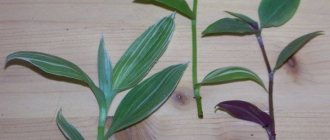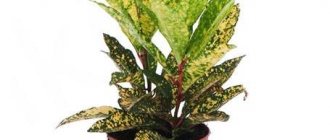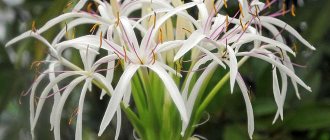Alpine violet - botanical description and types of flowers. Necessary conditions for care: temperature and moisture during the active period and during rest. Reproduction methods - you can get the most complete information about all this from this article
Alpine violet: flower photo
Description of alpine violet
Its other common name is cyclamen purple (European), and colloquially known as dryweed. This flower can be found along the entire Mediterranean coast and in the mountains of Northeast Africa. The plant loves cool weather and does not tolerate heat at all. Therefore, its life cycle is divided into two periods: rest and growth. In the summer, the alpine violet sheds its leaves and “falls asleep,” and in the fall the growing season begins. It blooms all winter - from October to March.
The buds of this plant have delicate oblong petals of white, purple and pink colors. Green leaves with silver patterns are shaped like a heart.
How to distinguish European cyclamen from Persian
The above describes what European Cyclamen and C. Persianus look like; modern hybrids and varieties differ from natural species and from each other in external characteristics (color of flowers and leaves, size), flowering time. It is difficult for non-specialists to understand this diversity. Let's find out what the most noticeable differences are.
Distinctive features of the two types of Cyclamen:
| Plant Features | C. purpurea (European) | C. Persian |
| Coloring the undersides of leaves | Shades of purple | Green |
| Tuber | It is completely immersed in the soil, the roots are located over its entire surface, over time it loses its original shape, becomes lumpy, and is overgrown with “daughters”. | Usually protrudes above the ground level, disc-shaped, roots extend from the lower surface (bottom), “daughters” are not formed. |
| Bloom | In spring and summer for 4 months. | In autumn and winter for 3 months. |
| Rest period | Retains foliage all year round, there is no pronounced resting phase. | The duration of hibernation depends on the variety and condition of the plant. |
Based on the listed characteristics, you can at least roughly determine the type of cyclamen. Modern hybrids are more adapted to indoor growing conditions; their characteristics are not so strictly defined.
Varietal series have been developed that are tolerant to heat and low light levels, suitable for year-round cultivation. This is just a short list of new trends in cyclamen breeding.
Interest in original, natural species will most likely remain the lot of the most experienced gardeners. It is more important for ordinary lovers of indoor plants to get more information about the varieties and hybrids that they have already added to their collections or are just about to do so.
Types of alpine violet
Alpine violet has more than 20 species. But due to the difficulties of care, only two are grown at home: Persian and purple.
| View | Description | Leaves | Flowers |
| Cyclamen persica | The perennial, up to 30 cm high, has a round fleshy root formation, 15 cm in diameter. It does not form daughter shoots. | Large, up to 14 cm in diameter, grow from a tuber, heart-shaped, dark green with a light pattern, red-brown petioles. | They have five pointed, curved petals, up to 5 cm long. Rich colors: white, pink, burgundy, purple, dark red. |
| Cyclamen purple (European) | A low plant 10-20 cm in height. Small tubers are entwined with root shoots. | Small - 2-4 cm, round. The upper part of the leaf is green with silver painting, the lower part is dark red. | Consist of five drooping petals of pink, rich crimson or purple. Cherry flower stalks. |
Popular varieties in indoor culture
More than 200 varieties of cyclamens are produced in Europe alone. The main centers are located in the Netherlands, Switzerland, and France. New varieties are more beautiful than classic indoor cyclamens. The flowers of one of the showy white cyclamen "Pom-Pom" look like little snowballs.
Varietal Persian
In floriculture, cyclamens are divided into groups depending on the size of plants and flowers, and the characteristics of the petals. There are varieties with large flowers, which have whole or fringed petals:
- Rococo - cyclamens with wavy flowers and fringed edges.
- Cristata - flowers with a feathery comb.
- Victoria - with a red eye and a colored border.
Based on the size of the bush and flower, mini, midi and maxi cyclamen are distinguished. Caring for them is the same as for classic varieties.
The mini group includes the “Miracle”, “Silverado”, “Midori” series. The suitable pot size for these plants is from 6 to 10 cm. Many cultivars have an aroma.
Midi-cyclamen series: “Laser”, “Sterling”, “Snowridge”. Such plants need pots with a diameter of 10–14 cm. Midi flowers from the “Laser” variety series are smaller than those of classic varieties and look like light moths.
- Large-flowered or maxi-cyclamen “Perfetto”, “Sierraa”, “Snowridge”. They are suitable for containers with a diameter of 11–19 cm.
- The flowers of the “Fantasia” variety series enchant with their unique coloring. The petals are bright pink, almost red at the base, light pink and white at the top.
- A feature of the Tianis variety series is the compact size of the plants (midi) and the early onset of flowering.
- Cyclamens of the “Super Serie” variety series - red, lilac, white with straight pedicels, profusely flowering, mini or midi.
- Variety series "Halios" - flowers are white, pink, dark red with an almost black center, very beautiful green leaves with a white openwork pattern of spots, lines and dots.
- The buds of the cyclamens from the “Petticoat” series are pink or lilac, looking like open bells. "Petticoat mix" - plants with peach, raspberry and all-white flowers.
Cyclamen with fringed petals and double
- Series “Jive” (“Jive” F1) - cyclamens with elegant wavy petals, a total of 8 varieties with brightly colored flowers.
- The early variety "Friller" is a large-flowered cyclamen with corrugated petal edges. The color of the flowers is deep pink, white or pale pink.
- The “Latinia Pipoca” variety series is notable for the fact that the flowers look like double violets.
Cyclamen "Victoria" is a variety with two-color white and pink petals with wavy edges.
Cyclamens delight with a rich range of colors, unusual shapes of petals, and shades of leaves. Among this wide variety, you can find a plant for any occasion: a gift, a living bouquet, for your home.
When caring for cyclamen, it is important to observe moderation: do not allow the soil to become waterlogged or dry out, and place the flower pot in a bright, cool place. In summer, the plant requires quite a long rest. Proper care of cyclamen, taking into account its needs, will help extend the life of a beautiful flower and with its help create your own floral oasis on the windowsill overlooking the winter nature.
Compare how to grow the common Usambara violet to decide which flower is best for you: cyclamen or Saintpaulia violet.
Alpine violet: care at home
An unpretentious flower in natural conditions requires special attention when grown indoors. Only with the right approach, cyclamen will not die and will bloom for several months in a row.
| Flowering period | Rest period | |
| Location | During the winter months, plants are placed on western or eastern windowsills with good lighting. Or on shelves with additional lighting. | A darkened place in the garden or on the balcony. Better in the fresh air. Can be installed between window frames. |
| Temperature | The optimal temperature during this period is +17…+19 °C. The flower will perceive an increase to +25 °C as a signal for hibernation. | During this period, the plant does not react much to elevated temperatures. The coolness of the night on a loggia or balcony has a beneficial effect on bud formation. |
| Watering | It does not like dampness, so water it abundantly, but not often, preferably through a tray - this way the water does not get on the leaves and tubers. | Just lightly moisten the earthen ball with cold water, preventing the tubers from drying out and cracking. |
| Feeding | Only adult plants once every 2 weeks at the rate of 1 g/1 l. Any mineral potassium-phosphorus mixtures with a reduced amount of nitrogen are suitable. | Not produced. |
Recommended by topic
Basic rules for watering indoor plants 6 simple ways to determine the acidity of the soil yourself When and how to use hydrogen peroxide to benefit indoor plants?
In winter, cyclamen will grow and develop normally only if the temperature range is within 10-14 degrees Celsius. In warm weather, comfortable levels are 20-25 degrees.
In summer, it is better to keep the plant in a shaded part of the apartment or a shady front garden.
Humidity and watering
To water cyclamen, use soft, settled water at a temperature 2 degrees below room temperature. It is poured into containers a day before the procedure and carefully settled.
During the flowering cycle, the crop requires maximum watering. Drying out any layers of soil has a detrimental effect on the flower. The same goes for excess moisture.
When growing cyclamen, many growers practice bottom watering (using a tray). In this case, water does not get on the tuber, buds and core.
After moistening the soil after 2-3 hours, the remaining liquid should be drained from the pan. When the cyclamen begins to bloom, the frequency of watering is reduced, and after the foliage dries and the tuber is exposed, it is reduced to a minimum.
To maintain comfortable air humidity, the bush is moistened with rain or soft, settled water from a sprayer. But such treatment is recommended only before the budding period. After the flower buds appear, moistening is carried out according to a different scheme: wet peat or pebbles are placed in a tray, and a flower pot is placed on top. At this moment, the bottom of the container should not come into contact with the liquid.
Top dressing
It is customary to fertilize cyclamen from the moment the first leaves appear. organic or mineral preparations are suitable for this procedure
The following fertilizers are quite effective:
Uniflor flower
Pokon
Bona Forte
Also, homemade compositions, such as:
Potassium solution It is prepared on the basis of purchased potassium granules, which dissolve in cold water. Excessive feeding of cyclamen with potassium solution is not recommended.
Wood ash To prepare a liquid mixture, dilute 3 tbsp in 1 liter of warm water. l. ash. This supplement contains potassium, zinc, phosphorus and many other useful microelements. Dry ash is added to the soil during replanting work, which prevents tuber rotting.
Eggshells are crushed and distributed over the substrate. The shell reduces soil acidity and plays the role of a leavening agent.
It is not recommended to allow an excess of nitrogen in the soil, because this component can provoke the formation of rot on tubers.
Transfer
Replanting work is carried out every year in September or August after the first leaves appear from the tubers. The container for transplantation is selected wide and filled with a fertile soil mixture with an acidity pH of 5.5-6. The optimal composition consists of sand, peat and humus, taken 1 part each, as well as 2-3 parts of leaf soil.
Also suitable for growing cyclamen is a substrate combined in a 1:2:4 ratio, based on:
Sand
Humus
Leaf soil
If the acidity is above 6.5, there is a risk of developing fungal diseases.
After removing the bush from the container, the rotten roots are trimmed. At this stage, it is important to take special care so as not to damage healthy roots and deteriorate the condition of the crop.
When replanting a tuber, the following rule is taken into account: it should rise ½ or 1/3 above the ground. This ensures lush and stable flowering.
To prevent stagnation of liquid in the roots, a high-quality drainage layer is made at the bottom of the container.
Priming
From the finished substrate, a universal soil with neutral acidity, or a soil mixture for keeping tulips, is suitable:
BioMaster
Universal
ZeoFlora
It is recommended to add a small amount of vermiculite or sand to the finished soil to increase water and breathability.
Fine expanded clay is used as drainage material. This layer takes up at least ¼ of the entire volume of the pot.
Trimming
Cyclamen is trimmed only after it has finished flowering. Peduncles and leaves are trimmed right down to the tuber.
Along with this procedure, the grower needs to reduce the frequency of fertilizing and active watering so as not to stimulate the formation of new shoots.
Correctly performed and timely pruning will significantly improve the condition of the crop and help it gain new strength before future flowering.
It has faded, what to do next?
After the cyclamen finishes blooming, its leaves will begin to turn yellow and fall off. This indicates that the plant is entering a dormant stage, when it requires particularly careful and careful care in compliance with a number of rules. Dried leaf blades are cut off, and strong leaves are trimmed for tubers. You can't tear them off.
At the dormant stage, systematic but infrequent watering is recommended. Drying out the soil is unacceptable, so it is important to keep it slightly moist.
It is better to move the container with cyclamen to a cool and shaded place. Once the growing season resumes, the flower can be transferred to its usual mode of maintenance.
Transplantation and soil
Alpine violet is replanted during the hibernation period closer to autumn, when the buds of leaves appear on the bulb with roots. The size of the pot should be slightly larger than the diameter of the tuber with roots. Flowering does not occur in a large container.
Cyclamen persica
A layer of drainage is placed at the bottom, then the soil mixture is filled. To do this, mix peat, sand, garden soil and humus in equal proportions. Dried or rotten roots are removed from the surface of the rhizome and immersed in the ground. Persian cyclamen must be deepened by 2/3, and European cyclamen can be completely covered with earth. If propagation is planned, then before this the bulb is cut, leaving buds and roots in each part. The cut area is treated with coal.
To accelerate growth, the tubers are sprayed with special solutions and allowed to dry in the sun, but not in direct rays. Then they are rooted into the ground. After transplanting, the pot is placed in a cool, bright place. Before the first leaves appear, watering should be sparse.
When propagating by seeds, it is necessary to put the earthen mixture in a shallow container, deepen each grain by 1 cm and level it. Cover the top with a light-proof film and moisten the soil regularly. After 30-50 days, shoots will begin to appear.
Cyclamen Purple
Reproduction methods
To propagate cyclamen at home, tubers, pups and seeds are used. Each method has its own characteristics and disadvantages. Since it is difficult to grow cyclamen from seeds, the tuber division method is most often used.
Tuber division
The cyclamen flower is most often propagated at home by dividing the tuber. To do this, during the dormant period, the plant is removed from the pot and divided into several parts. Each part must have a growth point. The place where the cuts were made is dried and treated with “Kornevin” or activated carbon. The prepared parts are planted in separate pots with an earthen mixture for cyclamen.
On a note! With this method of propagation, the risk of death of the new plant and the mother tuber increases.
Growing from seeds
You can plant and grow cyclamen from seeds. How to get them? In order for seeds to appear, artificial pollination is necessary. Seeds are sown in August. The planting material is pre-treated by filling it with a 5% sugar solution. The floating seeds are thrown away. The remaining planting material is soaked in a zirconium solution for 24 hours. This improves germination.
An earth mixture is made from equal parts of leaf soil and peat. The soil is moistened and seeds are sown. Planting material is sprinkled with a small layer of earth. The pot is covered with film and then placed in a shaded place where the temperature ranges from 18 to 20 °C. The soil is periodically moistened and ventilated. After 1.5 months, the first shoots appear.
When the first leaves form on the plants, the film is removed and the pot is moved to a lighted place, avoiding direct sunlight.
The air temperature should be 15-17 °C. Around December, second leaves appear and small tubers form. At this time, the cyclamen are planted. Since the shoots are still young, the picking method is used. The pots are filled with an earthen mixture of 2 parts leaf soil, 1 part peat and 1/2 part sand.
When transplanting, the planting material is completely covered with soil. The seedlings are fed a week after planting with complex fertilizers. Before the dormant period, the plants are transplanted into separate pots, leaving 1/3 of the tuber above the ground.
Alpine violet: garden care
The ideal place for planting in the garden would be the crown of any tree or the base of a bush. This will protect the flower from excess moisture during rain and from direct rays of the sun. Cyclamen loves loose soil that allows water to pass through and does not retain. To do this, it is best to dig holes and fill them with a soil mixture of turf and leaf soil with the presence of crushed stone, which serves as drainage. In garden conditions, the tubers are deepened by 10 cm to prevent freezing during the cold period.
During flowering, alpine violet needs frequent watering. Moisture getting into the rosette of leaves leads to rotting of the plant. Dried buds and yellowed leaves are removed.
Before winter, cyclamen is covered with a thick layer of foliage. Such a blanket will prevent the flower from freezing and retain moisture in the soil.
Cyclamen in the house: signs and superstitions
Many people grow alpine violet at home and have no idea about its effect on humans. There are several signs that characterize the influence of cyclamen on households and homes.
Popular opinions about the plant:
- Helps with depression, fears, problems in the love sphere.
- Strengthens family relationships among family members.
- Protects against bad energy.
- Relieves insomnia.
- Cleanses the human biofield.
- Accelerates the receipt of material benefits against the backdrop of professional growth and a successful career.
Before buying cyclamen, it is useful to read the rules for growing Alpine violets and choose a variety that is easier to care for. If you follow the recommendations, delicate pink buds are pleasing to the eye, despite the frost and blizzard outside the window.
Below is a video, after watching which you can learn more secrets of growing cyclamen, which will help keep the plant in flowering state all year round:
Diseases and pests
| Symptoms | Causes | Elimination |
| The leaves turn yellow during the growing season. | Dry air, high temperature, lack of watering. | Ensure regular watering, spray the space above the flower with a spray bottle, and put it in a cool, bright place. |
| Leaves and flower stalks rot, brown spots appear. | Excessive watering, water getting into the outlet and onto the tuber. | Remove the affected parts of the plant, dry it, sprinkle with coal. Replace the soil, ensure good soil ventilation. |
| Flowering stops, the tips of the leaves turn yellow. | Fungal infection. | Replace substrate. Treat the flower with Topsin-M. |
| White coating, dark spots on the leaves. | Gray rot. | Transplant the cyclamen into another pot, treat it with a fungicide, and limit watering. |
| Flowers and leaves are deformed and covered with white streaks. | Thrips infestation. | The plant is isolated and disinfested with Spintor, Fitoverm, etc. |
| The leaves turn yellow, become covered with a gray coating, and growth and flowering stop. | Infection with cyclamen or spider mites. | Treat with insectoacaricides: Danitol, Mavrik, Sumiton, etc. |
Care errors and their elimination
Useful information about negative phenomena on indoor flowers is collected in the table:
| Problems | Causes | Elimination |
| Brown spots on tubers and leaves | A consequence of waterlogging of the soil and cool air in the room | Reduce the number of waterings and normalize the temperature in the room. |
| Yellowing foliage | Low humidity in the house, insufficient soil moisture | Increase the regularity of watering and prevent dry air. |
| Yellowed foliage and cuttings | Using hard water | The liquid must settle |
| Falling leaves | Insufficient nutrition and moisture in the soil | Increase the amount of watering and fertilize with mineral or organic fertilizers. |
| The buds are hidden under the foliage | Low temperature in the home, insufficient lighting, humid air | The temperature regime is brought back to normal, the amount of light is increased, and the humidity is normalized. |
Mr. Summer resident recommends: medicinal properties of alpine violet
The healing qualities of cyclamen have been used for several centuries. Its tubers contain substances that help fight nasal polyps, sinusitis and sinusitis. Baths with decoctions relieve arthritis pain. Alcohol tinctures from alpine violet bulbs are used for rheumatism, gout, intestinal disorders, and migraines.
Sprays containing an extract from the plant's rhizomes have an antiseptic and antimicrobial effect. In folk medicine, to remove pus from the sinuses during acute inflammation, fresh juice is prepared from crushed tubers and 1-2 drops are dripped into each nasal passage just once. This is enough for the discharge of pus to begin within half an hour. Failure to comply with the dosage can cause an allergic reaction and poisoning, because cyclamen is a poisonous plant. To avoid this, all medications based on it are used on the recommendation of a specialist.
Classic problems
Yellowing of leaves
After flowering, the foliage and root system will deteriorate. If the rhizome looks good externally, the plant may be too hot. Yellow spots appear when exposed to direct sunlight, dry air or excessive watering.
Short flowering period
It is usually caused by a combination of dry and warm air or lack of water. Provided that the plant bloomed profusely at the time of purchase.
Leaves are limp and drooping
The plant dies due to excessive watering. The soil must be changed immediately.
Threat factors and protective measures
The rare violet is at risk of complete extinction due to human economic activity: early haymaking, deforestation.
Humans’ rude attitude towards the surrounding nature also has a negative meaning: numerous unauthorized landfills, trampling of grass, destruction of flowering plants.
One of the varieties of mountain violet (photo)
In order to protect the endangered species of the described violet, it is necessary to carry out comprehensive measures aimed at preventing a reduction in its number:
- search for new habitats;
- monitoring the existing population of the species;
- a complete ban or restriction of human economic activity in habitats (haymaking can be done after the violet seeds have ripened - in the second half of summer, felling should be selective and of sanitary significance);
- Implementation of improving the culture of human behavior during his stay in nature.
Mountain violet is currently rarely cultivated, but to preserve the species it is possible to develop programs for its cultural propagation.
Expert opinion
Yulia Yurievna
I have a large garden and vegetable garden, several greenhouses. I love modern methods of cultivating plants and mulching the soil, and I share my experience.
Ask a Question











